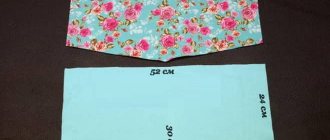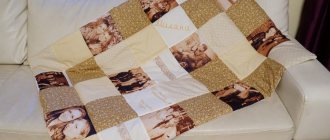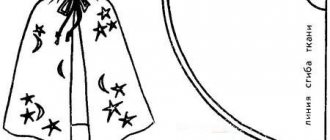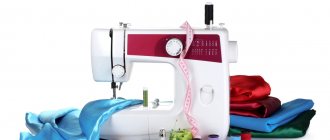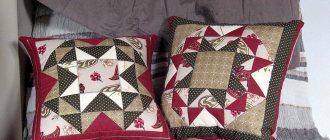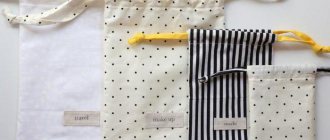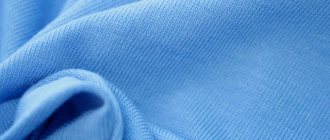Every person in his life has encountered such an element of clothing as an apron. It is worn in educational institutions, for example, during creative work in kindergarten, during a labor lesson at school. Children are given the task of making such products on their own, and often turn to their parents with the question of how to sew an apron, and sometimes adults do all the work for them.
The skill acquired in childhood will definitely come in handy in the future, because for many people the hem is part of their workwear. It is worn by cooks, waiters, hairdressers, salespeople, laboratory assistants, and representatives of other professions. Housewives use this item in the kitchen when cooking, cleaning, and washing. It helps protect things from dirt, grease and stains.
History of the apron
Now it is impossible to say exactly who and when the first apron was invented. Historians believe that the products appeared in Ancient Egypt, as evidenced by the images found in temples and burials that have survived to this day. The first prototypes date back to the Early Kingdom period. They were called “shenti”, they were worn exclusively by men in public service, as well as by the upper classes and pharaohs.
Subsequently, this item was borrowed by the Arabs, who for many centuries created their clothes in the image. This element migrated to Ancient Greece, where a great influence of the East can be traced, and then to Ancient Rome. If the Greeks' clothing was colorful and stiff, the Romans at the beginning of the Republican period preferred simple, strict forms.
The following mentions of the apron date back to the Middle Ages, where in Western Europe, starting from the 12th century, it became the subject of decoration for noble women. For men, it was part of the workwear wardrobe. This item was used exclusively as protection, as an addition to the main suit.
Products appeared in Eastern European countries later. The word itself has been found in Russian written language only since 1663, in Polish - since 1498. The designation came to the Western Slavs, and later to the Eastern Slavs from the German language. Literally translated as front scarf. They were used as work clothes, national costumes, and festive decorations.
A little history
Like many items of modern women's wardrobe, the apron was borrowed from men. Moreover, in ancient times it was worn by representatives of very courageous professions: warriors, gladiators, priests. In the Middle Ages, it became an attribute of artisans, guild masters and, finally, cooks.
As a ladies' accessory, it was used in elegant clothing of the nobility, decorated with lace, embroidery and trim. Over time, the apron became a completely utilitarian thing for women of the simple class, protecting their clothes, although the tradition of decorating it remained.
Where and how are aprons used?
Aprons have long become a familiar element of the wardrobe, which can be found not only in the kitchen, but also in everyday life. It is used almost everywhere. They are worn by women, men, adults, children. This subject has developed over centuries, even millennia. He won the favor of people, and sometimes went away. Now this thing is used in the following cases:
- Life Housewives use an apron when cooking, washing dishes, and doing other housework.
- Kindergarten. They are worn by children when eating, during creative activities using paints, plasticine, and other branded items.
- School. Boys and girls wear them during labor lessons. Women decorate their school uniform with an apron during holidays and various events.
- Medicine. There are models for different categories of medical personnel. They are used by surgeons and nurses.
- Communal sphere. Special protective aprons for janitors and plumbers.
- Service sector. They are worn by sellers, hairdressers, shoemakers, maids, loaders, and cleaners.
- Public catering. This is a mandatory attribute for cooks and waiters.
- Production. The apron is intended for turners, metal washers, blacksmiths, and welders.
- Chemical industry. Protective products are used by laboratory technicians when working with various reagents.
- Fishing industry. They are used by workers in fish shops and fishermen who go fishing.
Fabrics used
The fabric for the apron is selected taking into account the conditions of use of the finished product. Basic requirements for materials:
- strength;
- easy care, resistance to frequent washing;
- antistatic properties, the material should not attract dust.
In many cases, it is convenient to use a waterproof apron that can prevent clothes from getting wet when working with water.
The appropriate fabric for the apron should be beautiful. This is important both for housewives who want to be dressed up at home, and for beauty salon workers, waiters and representatives of other professions who work with people.
Materials that are suitable for sewing:
- Cotton. 100% cotton is rarely used because it wrinkles a lot. More often, preference is given to mixed textiles containing synthetics.
- Linen. Linen aprons are often used for decorative purposes, since it is difficult to remove stains from natural linen, and it wrinkles a lot. But linen aprons decorated with embroidery look attractive; they can decorate the hostess while receiving guests.
- Synthetics. The most commonly used material is polyester. Materials made from synthetic fibers do not wrinkle, dry quickly, and do not require smoothing. You can make a kitchen apron from synthetics for daily use. This material is most often used for sewing workwear intended for service sector workers.
Recently, fabrics with special impregnations that impart water- and dirt-repellent properties have become very popular. A good solution could be a Teflon-coated material. The base can be anything - cotton, calico, viscose, synthetics. A polymer layer is applied on top of the base.
Types of aprons
There are many varieties of these products. According to their cut, they are divided into the following types: cut-off with a bib, one-piece, without a bib. By gender and age category: women's, men's, children's. By purpose we can distinguish:
- Kitchen;
- Children's;
- Workers;
- School;
- National;
- Holidays.
By functional purpose:
- Decorative. Used as decoration.
- Standard. Used to protect clothes from dirt and grease stains.
- PPE (personal protective equipment). These include: chemically resistant (laboratory grade); moisture resistant food grade; canvas (for the welder); lead (for protection against radiation, used by radiologists and patients).
Types and styles
There are two main sewing models: an apron and a standard kitchen apron. To sew an apron, just cut out a fabric rectangle and sew a belt to it. The apron has a somewhat complex design; it is equipped with straps and pockets. It covers most of the body.
According to their purpose, the following types of kitchen aprons are distinguished:
- kitchen;
- children's;
- worker;
- school;
- National;
- festive.
Festive
National
School
Worker
Children's
Kitchen
According to their functional purpose, kitchen aprons are:
- decorative - they are used as kitchen decoration;
- standard – saves from grease and stains during cooking;
- personal protective equipment - these are chemical aprons for working in the laboratory, canvas aprons for protection during welding work, lead aprons for protection from radiation.
There are also different models depending on the pattern:
- rounded edge at bottom;
- hem in the shape of a semicircle;
- sundress;
- using flounces, ruffles, inserts;
- with pockets;
- asymmetrical cutting method.
There are original aprons that you sew yourself:
- knitted, made using the patchwork technique;
- denim;
- from a man's shirt;
- with various decorative elements and photo printing;
- sewn in different styles.
For those who are trying to sew an apron for the first time, it is recommended to start with a standard straight model, decorated with simple decor.
Fabric selection
When sewing an apron yourself, a very important point is choosing the right material for the job. First of all, it is necessary to take into account the fact that the product must protect clothing from contamination and at the same time decorate a person, therefore the selected textile must meet certain requirements:
- Convenience. The material should not cause discomfort to the wearer.
- Wear resistance. The fabric used must withstand frequent washing.
- Naturalness. It is better to use natural raw materials that do not have a negative effect on humans.
- Strength. During long-term use, textiles should not lose their structure and quality.
- Attractive appearance.
All fabrics that can be used for self-sewing the finished product can be divided into three main types:
- Natural. These include cotton, linen, and silk. They are highly breathable, hypoallergenic, pleasant to the touch, and retain color for a long time.
- Synthetic. These include lavsan, fleece, acrylic, polysatin. They are very durable, wear-resistant, and have a water-repellent coating. However, they are afraid of high temperatures, do not allow air to pass through, and accumulate static electricity.
- Mixed. These are taslan, tisi, duspo, taffeta. They are low cost, easy to clean, do not fade when washed, and have increased wear resistance.
Choosing fabric for sewing an apron
Before you start sewing the product, you need to decide on the fabric. Among the many characteristics of textiles, material types are the most important. It depends on them how practical, convenient and durable the product will be. There are 3 main types of fabric used for manufacturing:
- Blended fabrics that combine synthetic and natural fibers. Aprons made from such materials are durable. The downside is that they quickly lose their original color and fade during washing.
Mixed fabrics
- Natural fabrics such as silk, cotton, wool, linen - products have an excellent appearance and high wear resistance. They wrinkle easily and take a long time to dry.
- Synthetic materials are hypoallergenic, inexpensive and durable. The materials become electrified and do not allow air to pass through well. As a result, a person often becomes hot in a product made of synthetic fabric.
You might be interested in Patterns for dresses with wing sleeves: for children and adults
Synthetic materials
Aprons for chefs in cafes or restaurants are a separate case. This element of the uniform must be comfortable and safe and meet established requirements. Therefore, aprons for chefs are made from high-quality calico with a mixture of polyester. Main characteristics of this material:
- resistance to wear and washing powders;
- environmental cleanliness;
- low cost;
- high density, strength;
- ease of care and ironing.
The most suitable fabric for cutting a professional apron contains 30% cotton threads, 70% polyester. This option is more expensive than calico, but it also has more advantages. The optimal combination ensures resistance to deformation and hygiene. A prerequisite is a special impregnation that protects against the effects of hot steam, fat, and boiling water.
Professional chef apron
Home wear items are not subject to such strict requirements as professional uniforms. And what fabric to choose for an apron, a woman can decide for herself, guided by her own preferences.
Here are the most popular modern options that are well suited for creating a home apron:
- Presentation “Apron with bib” 6th grade
- “Diagonal” – cotton fabric with a small addition of synthetics. Special weaving of threads gives an interesting texture with a rough surface. It has elasticity and high density. Pros: thermoregulation, strength, resistance to deformation, pleasant to the touch.
Diagonal
- Linen is an impractical fabric because it absorbs dirt well, can shrink after washing, and requires careful ironing. It has more decorative value - it is difficult to compete with it in terms of aesthetics. It perfectly complements the interior in the Provence, Modern, and Country styles. An apron made of this material is suitable as a decoration for a hospitable hostess during a holiday or as a gift. The stores offer a wide range of fabric colors with and without prints, at an affordable price.
Linen
- Synthetic is a fabric that is inexpensive, easy to wash, and dries quickly. A housewife may have several items made from this material in her arsenal for every day. It is only important to choose high-quality synthetics that will not fade or pill after the first wash.
- Teflon-coated material is viscose, cotton, calico or synthetics, the surface of which is coated with a polymer layer. As a result of processing, the material is waterproof, does not absorb dirt, and reflects heat. An item made from such material can be safely machine washed on any mode. The downside is that it is sold only in specialized fabric stores, and the cost is relatively high.
Teflon coated material
Please note! When choosing brightly colored fabric, you must ensure that it does not stain clothes and skin under the influence of high temperatures.
Quite often, needlewomen use old clothes to sew products - denim, leather goods, bathrobes. Thus, you can spend your time interestingly and usefully, save money and create an exclusive item.
What material are aprons made from? What fabric is best for an apron?
Cotton Cotton is a very common fabric and most manufacturers make aprons from this material. Cotton aprons are ideal for baking, especially when working with dry materials. Cotton is not waterproof or water-resistant, so it is not ideal for situations where your staff is handling any liquids, media or products. 100% cotton aprons are commonly worn at home, as well as in the kitchen of a restaurant, bakery or cafe. But there are a huge number of colors for cotton aprons - you can always choose a color scheme to suit your business concept.
Polyester Polyester is one of the widely used materials among clothing manufacturers around the world. Remember that polyester is a 100% man-made fiber based on plastic. It has unmatched durability, the ability to withstand multiple washes, and is wrinkle and shrink resistant + it dries quickly.
However, it does have a few drawbacks, such as being less breathable, temperature sensitive, and a slightly rough texture that may be uncomfortable for those with sensitive skin.
Polyester is common in industrial aprons as they will provide better protection than cotton aprons. Polyester aprons are also commonly used when working with chemicals, paints, and other materials that can easily damage clothing.
- Reaper fabric: what is it, what types are there, what is best to sew from reaper crepe?
Polyester+cotton
At LILACS.RU you can buy aprons containing 65% polyester and 35% cotton with water-repellent impregnation. An unrivaled combination of breathability and fabric durability - now all together! Such aprons are not only comfortable, practical and easy to wear, but also provide good protection from moisture, dirt and various types of products. The recommended washing temperature is not higher than 40 °C - to preserve the water-repellent impregnation on the fabric. In the LILACS.RU catalog you can buy an apron with or without a bib (short apron) with a universal size for a wide variety of sizes of your staff. Models of such aprons can be worn during any type of work: whether you are a hairdresser, stylist, barber, manicurist and pedicurist, barista, bartender, waiter, cook or florist - aprons with water-repellent impregnation will become your favorite uniform for a long time.
Leather is perhaps one of the best fabrics for an apron - it is very durable and wear-resistant. Leather aprons are great for those who will be working with mild chemicals, heat and other products. Leather products will effectively protect you - they are ideal for a wide range of work areas. They will also last you a very long time, so they are a good investment in your future. Nowadays, leather aprons are very expensive, so eco-leather aprons have replaced them. Aprons made from this material also have many advantages. Leather aprons are perfect for hairdressers, stylists, barbers and bartenders. Now aprons with leather inserts have become very popular all over the world.
Other Materials There is a list of other materials you can also choose from, including nylon, rubber-coated cotton, and more. Each of these materials is ideal for different conditions and can be useful for different applications. While cotton, polyester, polyester+cotton blend, and leather are the most common materials for aprons, there is a list of other options that you can also consider. A polyester apron is often an excellent choice for a quick application or one-time use. But for long-term use, for example, for cooks, waiters or people who work in an industrial environment, it is better to choose aprons made of cotton or cotton + polyester.
Styles and models for aprons
In a full-fledged family in the kitchen there should be at least three aprons for all its members: women's, men's, children's. Each is characterized by a certain appearance and color. After choosing the fabric suitable for the job, you should decide on the model of the future product. To do this, consider the existing styles:
- Aprons. This is the most basic design, consisting of a piece of fabric and a belt, which is tied at the waist. This protective clothing only protects the front part of the outer clothing.
- One-piece with bib. This model covers the chest, stomach, and hips. Attached to the neck and belt. Made from a single piece of fabric. This is a more practical option compared to the previous one.
- Cut-off with bib. It is similar to the previous version, but only partially covers the chest area. These cute pieces accentuate your waist. It consists of a belt, lower part, and bib.
To get a more practical product, you can sew pockets into it, in which you can put small things, freeing your hands from small items. To sew it, the same material is used as in the manufacture of the apron itself.
Pattern and sewing
Essentially, an apron is a dimensionless piece of clothing without fasteners or buttons. For sewing you will need a sewing machine, pattern paper, a piece of fabric, scissors, thread and decorative elements as desired.
Instructions for sewing the product:
- Draw the pattern diagram on graph paper, preferably graph paper. The classic apron pattern consists of two rectangles (hem and chest), three stripes and a pocket.
- Cut out the pattern and transfer its elements to the fabric, taking into account seam and hem allowances.
- Sew fabric pieces together. At the same time, tuck the edges and sew on a typewriter.
- Lastly, sew on the pocket, ribbons on the sides and one for fastening on the neck.
- Decorate with decor as you wish.
The design of a modern kitchen accessory is not limited to just pockets. Frills, embroidery, ornaments, prints, thermal stickers are used separately and combined with each other. This upgrade is inexpensive and adds originality to the clothing. Sewing from recycled items is a popular trend. Choose the style yourself: glamor, military, ethno, rock, romantic, etc.
Creating a pattern
Creating a pattern is the most difficult moment in all the work. Only after solving this problem can you start basting the parts and sewing the product. To prepare the sketch you will need to take the following measurements:
- semi-hip circumference;
- length, width of the bib;
- apron parameters;
- length of ties on the neck, belt.
Having taken measurements, you can begin creating a sketch. If you don’t have enough skills in drawing up a diagram, you can take ready-made models from specialized literature, download them from the network, replacing the existing sizes with your own.
According to the existing plan, templates are made for the apron, belt, bib, ties, and pocket. To do this, you can use thick paper or cardboard. Experienced craftsmen can apply details directly onto textiles. It is recommended to use half patterns, since it is much more convenient to cut out parts from fabric folded in half.
Sequence of sewing an apron
To make a fashionable, comfortable apron with your own hands, you need to choose the right patterns, decide on the type of fabric, style, and additional decor. The model is sewn with a bib in the following sequence:
- We prepare all the cut details for basting;
- We make straps, process the edges;
- We finish the edges of the bib and connect it with the straps;
- We attach pockets;
- We hem the free edges of the lower part of the apron;
- We connect the bottom, bib and belt.
Ideas for sewing aprons for the whole family
A kitchen apron is an irreplaceable thing. It is often used, performs many functions, so it must be not only practical, but also aesthetic. In many national costumes it plays the role of a decorative adornment. The variety of traditional kitchen utensils is very large. Any family member can choose the appropriate model and design method.
An apron is the first product that schoolchildren sew during labor lessons in high school. After studying the master classes, you can easily supplement your existing skills with a few accent details. A independently selected style and a creative model will always remind a woman of her individuality. In an apron with ruffles, beautiful folds of unimaginable colors, it is impossible to feel like a housewife. There are many unusual ideas for the whole family.
Aprons for children - boys and girls
All children love to help their parents in the kitchen. Useful experience and training for work do not always go smoothly. Children's clothes are often stained and dirty. It’s very easy to sew a bright children’s apron decorated with original appliqué with your own hands.
The simplest version of an apron for a child is made from oilcloth and multi-colored bags. You can complement it with buttons, pockets, funny lace, like a maid or waiter. An apron for a boy can be made using the same principle, but as decoration use a print with cars, airplanes, and steam locomotives. You don’t have to bother with complex appliqué, but simply cut and sew the design from the bag.
Apron for mom
You can also choose polyethylene as the basis material for an apron for housewives, decorate it with flowers and other feminine decor, but such an element will look unaesthetic and is only suitable for active cooking. The apron for guests should be fabric and elegant. They should definitely replace a well-worn apron with all the delights of kitchen life when guests arrive, during gatherings in the kitchen, and when serving dishes.
An apron with a straight silhouette and a simple style can be in any color. But the snow-white look will emphasize the cleanliness and well-groomed nature of the mother. You can also sew a beautiful protection using dress patterns or completely remake an item of clothing that has gone out of fashion, adding large hairdresser’s pockets, a bright belt, and frills.
Apron for dad
Many men take an active part in preparing dinners, therefore, like all family members, they need their own apron. A stylish kitchen accessory sewn by yourself will be an excellent gift. This could be a simple, cheerful version made of polyethylene, a high-quality, large-sized fabric bib, specially decorated with a stylish print.
An apron for dad can be more than just a kitchen apron. To work in the garage or around the house, you will also need reliable clothing protection. This is usually a fabric belt with many pockets for storing tools. Such an apron can be decorated with modest embroidery and a personalized sticker.
Apron from a men's shirt
You can sew a beautiful original apron from any clothing that is no longer used for any reason. The men's shirt is perfect for this purpose, thanks to the solid cut of the back and a large amount of material. There are several simple cut options (with a collar, assembled). The easiest one is from the back. The following master class will help you make patterns correctly:
- We prepare the back, cut off the collar and sleeves;
- We sew the edges of the future apron and iron it well;
- Sew the ties on the belt and the loop in the neck area;
- We decorate the horizontal seam at chest level with ruffles, frills, and decorative ribbons;
- Pockets and the lower part of the product are decorated as desired.
Apron made from old jeans
Old, unwanted trousers can easily be turned into an original apron in casual style. There are several ways to cut jeans - use one of the legs or sew only from the top part with the back pockets.
The apron from the trouser leg will be large, covering the entire length of the product. We make a pattern using a template, our own design or an existing apron. We process the edges with edging, for example, bias tape. We use the same ribbon for ties. The scraps of material will be used for pockets of any shape.
It is necessary to position the pant leg correctly when making the pattern. The factory seam should be strictly in the middle.
Another option for making a modern apron is no less simple than the previous one. Cut off both legs of the trousers and trim the upper part to the level of the fly. We process the edges from sprinkling, sew on ties, a beautiful belt, and pockets.
Patchwork apron
The original model is an apron in patchwork style. Elegant overalls made from many different pieces will create a holiday in the kitchen under any circumstances, and will make the process of even lengthy preparation of complex dishes simple and easy.
For work we prepare 30 patches of the same size. They can be of different shapes, but beginner seamstresses will find it easier to work with identical squares. We connect 6 pieces into a strip and sew them together. We also make 3 more blanks. Now we fold them into a large rectangle and sew them lengthwise. We connect 4 squares and place them in the center of the main part. From 2 more squares we form the upper part of the apron.
You can leave the apron in its original shape or make indentations. To do this, fold the product in half, mark a smooth bend on the outer square in the second row and cut off part of the fabric through both layers. A lining will help hide a large number of seams on the inside. We apply the future apron to a piece of plain fabric, cut it along the contour with a small margin. We place both parts together with wrong sides and sew them together. We trim the edges with white stripes. You can make ties from the same material.
Shabby chic apron
The pattern for a shabby chic apron differs little from standard models. What makes it stand out from other textiles is its stylish, festive decoration. This apron is decorated with ruffles, fringe, many pockets and linings. Each housewife chooses an arbitrary size.
For sewing you will need light fabric, plain or with a floral pattern, and a lot of textile decoration (ribbons, lace, flowers). The style is often used in a beautiful, voluminous style, with a gather at the waist. The main fabric is linen, thick cotton.
Features of sewing an apron made of polyethylene
For some unforeseen occasions, there is a great idea to sew an apron made of polyethylene, which is always at hand. These can be simple bags, packaging, wrapping material. The simple protection can simply be thrown away after use.
A film apron is very convenient for dirty work related to handicrafts (painting, felting). Suitable for a cook, artist. It is enough to take a piece of polyethylene 120x80 cm, fold it in half, and cut out the pattern according to the standard, simplest pattern. The role of ties will be played by film tapes from a single piece of raw material. You can decorate with any available materials.
What aprons can be like
A person can make a work of art out of any pragmatic thing, after which this thing can lose its original purpose. It would be more accurate to say that this thing takes on a different meaning - to please the eye.
It is believed that there are two varieties of this type of home clothing - aprons and aprons.
An apron is a complex and varied device for protecting the body. An apron is something that is in front. It has a simpler design and is often a rectangle with a belt sewn to it; it does not even have to have an upper part - a bib.
From this it follows that any rag tied at the waist and hanging in front, at least to the middle of the thighs, can be called an apron. In contrast, an apron is always a specially tailored garment, the distinctive feature of which is the closeness of the body in front and behind. The sides of this structure do not close together.
All aprons can be divided into the following categories:
Pattern of a wedge-shaped apron.
- women's;
- men's;
- children's;
- closed on both sides - front and back;
- for particularly dirty and dangerous work;
- small, covering only the very middle of the front part of the body;
- large, covering the body from the throat to the knees, and maybe even lower;
- simply beautiful, which may be their main function.
Thus, aprons have a variety of shapes and purposes and can be:
- Purely functional, designed for heavy and dirty tasks. Some work in the kitchen, and not only in it, is not particularly aesthetically pleasing or comfortable. There is no time for color schemes and frills.
- Purely decorative. They are worn only when beautiful clothes are not threatened by major stains, and the miracle of design tied over them and the pride of the owner will save them from minor stains.
- Beautiful and functional at the same time. This combination is found most often in kitchens, indicating that a person is ready to combine the joy of work and being in the most dynamic and visited room of the apartment.

